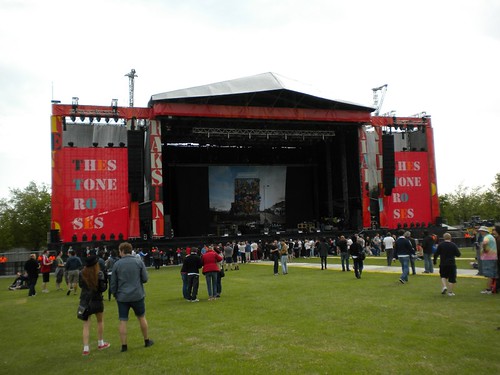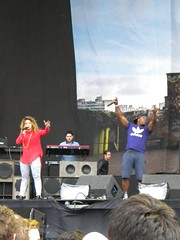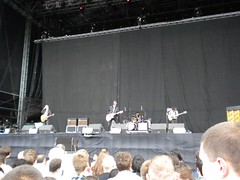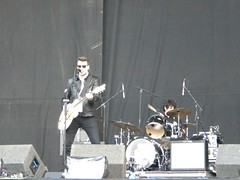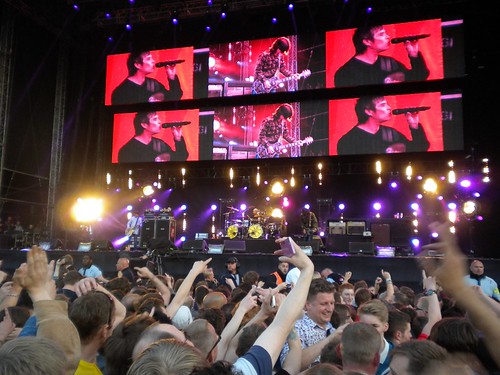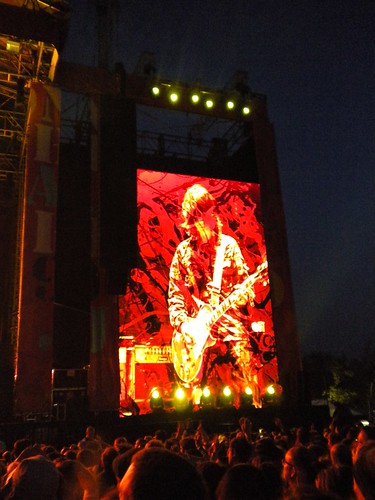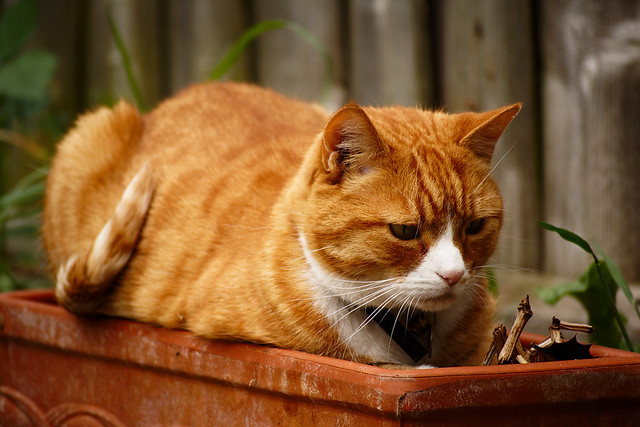The last episode of Ice Age Giants looked at why there are none of these large animals left. The first half of the programme concentrated on North America where there were the greatest proportion of extinctions. Roberts started by talking about the idea that it was people – we were treated to a proper true crime documentary moment where the voiceover was all “but beneath the peaceful streets of this Tennessee town lies a dark secret” etc etc. And saw how there is an excavation pretty much in someone’s back garden – of mastodon bones that look to have been hunted & butchered by humans. So was it people? Roberts pointed out the problems with that theory – not many people in North America at the time, lots of megafauna, and a few thousand years of overlap of people & megafauna.
So what else? How about the floods that created the coulees (also known as the Channeled Scablands) in Washington (the state). These features of the landscape are vast vast canyons that have been scoured out of the rock, but there’s no sign of a river. The theory to explain what caused them is that as the glaciers melted a great lake of meltwater was formed in Montana which is known as Glacial Lake Missoula, this was penned in by a dam formed by the melting glaciers. When it broke through it did so catastrophically and the water rushed to the west of the continent carving its way through the rock as it went. This happened several times as the glaciers advanced & retreated, I think she was saying a couple of hundred times over just a few thousand years. This would’ve killed anything in it’s path (and created what still looks like a blasted landscape today). But that can’t’ve killed all the animals, it would just’ve got the ones in its path.
How about climate change? This isn’t a case of it just getting a bit warmer all over – the melting of the ice sheets released more water into the rainfall systems, so the world got wetter as well as warmer. Still not quite that simple, the swamps that the glyptodonts lived in dried up & became desert because the rainfall moved north as the ice sheets retreated and the more southern regions warmed up. Roberts now skipped across to Europe and the woolly mammoths & woolly rhinoceroses of the Mammoth Steppe. These enormous herbivores relied on the dry grasslands to provide them with sufficient food all year round. As the world warmed up, and got wetter, forests grew where there had just been grassy plains. And it started to snow in the winters on the Mammoth Steppe. Woolly rhinos couldn’t cope with that – snow covers the grass and makes it harder to find, it’s also hard to walk through so you need more energy to move around and so more food. So that’s what killed off the woolly rhinos – an Ice Age Giant killed by it snowing too much, not at all what you’d expect.
And now we circled back to the mastodons of North America. There is research being done on fungal spores in soil that can indicate how many herbivores have left their dung on the land – if you look at soil from the past you can estimate herd sizes (or at least changes in herd sizes) over time. And these show that the large herds of mastodons & other herbivores died out before the climate change changed the vegetation (which you can tell by looking at seeds & pollen in the same soil samples). So probably not climate change as the whole story here. Roberts then talked to a palaeontologist who thinks he has an answer for the mastodon extinction. He has looked at the types of injuries on female mastodon specimens, and also looked at the types of mastodon that show signs of butchering. In modern elephants (which are close cousins of the mastodons) preferential hunting of mature adult males destabilises the herd structure. Normally a dominant male swoops in to a female plus offspring herd when the females go into heat and mates with the females. He also suppresses the behaviour of the adolescent males. When there is no dominant male, the younger males that still live in the female herd will go on a rampage when the females come into heat – and can injure females & calves (and each other) in the process. This palaeontologist thinks he sees evidence of this happening to the mastodons, so it was people that caused their extinction but in a very slow process caused by preferentially hunting solitary adult males which they wouldn’t’ve been able to see happening.
Last up for extinction were the woolly mammoths – which survived on a remote island north of Sibera until around 2000BC (when people arrived on the island). Apparently from the evidence on this island the mammoths were becoming dwarf mammoths … by mammoth standards anyway. Roberts talked a little bit here about the potential cloning of mammoths that is now becoming possible due to the extraction of DNA from very well preserved frozen specimens.
And Roberts ended the programme with a romantic notion of how we’ve also saved some of these Ice Age Giants – like horses. They became extinct in America, their ancestral home, but survived across Europe & Asia and were then domesticated. She was talking about it as a beautiful partnership, but I’m afraid I was amused by it rather than moved by it 😉
Anyway, I greatly enjoyed the series. The CGI wasn’t perfect (something always looked a little off about the way the animals moved, and there was a lot of repetition of sequences that made it a bit too obvious it was generated) but it was good. And the science was presented in an un-sensationalised way – lots of “we think” or “this is a possible explanation” rather than grand solutions to mysteries.
Having finished watching Brazil with Michael Palin (post) we started to watch another travelogue we had been recording – Australia with Simon Reeve. We’re both pretty sure we’ve seen Simon Reeve present another programme in the past, but neither of us can quite remember what it was.
In the first episode of this series he started in central Australia then headed south to the coast followed by west to Perth. In central Australia he focused on an animal you don’t expect to be the subject of a programme on Australia – the camel. Camels were brought to the country as a means of transport, being well suited to the desert conditions in the centre. With the advent of cars they weren’t needed any more & were released to the wild where they now roam freely. Unsurprisingly they cause a lot of damage to the ecosystem and to the farms in the region & so they are regarded as pests. Some farmers just shoot them when seen, but Reeve talked to one farmer who was rounding them up and selling them back to the Middle East for food & for racing.
Next Reeve went to visit a winery – a vast commercial winery with gallons & gallons & gallons of wine in big tanks, supplying relatively cheap wine to supermarkets across the world (this was owned by Hardys). This segued neatly in to a segment about how water is a limited resource & it’s being over used in Australia as a whole. Reeve then visited another limited resource – tuna, which is being overfished in the seas near the Australian south coast. He visited a facility where they’re trying to breed tuna in captivity, which involves conning the tuna into thinking they’ve migrated by changing the lighting and so on as it would change if they really were migrating.
From there to resources that are booming – he visited an area which has a modern day gold rush & talked to some weekend hobbiest prospectors, and also visited a huge commercial mine. Next, Reeve visited a village where an aboriginal community lives having been moved off their land when the mining companies discovered resources underneath it. They haven’t been compensated for the loss of the land, nor have they earnt anything from the metals being dug up from under what they still regard as their land. Reeve said that the situation is complicated & the government is trying to help, but the aborigines are still living in third world conditions.
From there he went to the other end of the spectrum – he took a train to Perth where he visited some British ex-pats who are living the dream. The man he spoke to had been a bin man in Sheffield, he’s now teaching people to drive trucks so they can work for the mining companies. His pupils earn more than he does, but he earns about £60k and has a big house with a pool etc, just what he came out to Australia for. And the episode finished up with Reeve visiting an airport where “fifo” commuters fly from – that’s “fly in fly out”, the commuters work in the mines (doing things like driving trucks for lots of money) and live in Perth getting back & forth by plane.
The second episode covered the north of Australia, which is particularly sparsely occupied. He started out in a national park (Kakadu) helping to trap & cull cane toads. These are a non-native species that was introduced to eat beetles that were pests … they didn’t eat the beetles, and being poisonous & non-native they have no predators amongst the native animals. So they’ve spread & are killing off the wildlife in the park which dies trying to eat the toads. The cull seemed a bit like it would just make the people doing it feel like they were trying – if there’s millions of toads then catching & killing a couple of bin bags full won’t do much good.
Moving towards the east Reeve visited the Australian army, first one of their tank regiments then he spent a bit of time on patrol with a unit doing observation in the outback. This segment reminded us that Australia is actually right next to Asia, rather than being a stray bit of Europe stuck in a southern ocean. In the bit with the patrol they talked about how the unit was mixed race & that this didn’t cause problems in a way that made it sound like that was an unusual situation. They also talked about how the aboriginal members of the team were vital in teaching everyone how to live off the land – they made green ant tea for Reeve, which apparently was quite nice … not sure I’d’ve been keen to drink it. The follow up to this section was a visit to an asylum centre, Australian law is that asylum seekers must live in these detention centres while their application is processed which can take months or years. Reeve spoke to activists on the behalf of these immigrants who say that conditions in the centres aren’t good – lots of the inhabitants self-harm or commit suicide. Reeve spoke through the fence to some of the inhabitants, who’d come from the sorts of places you’d expect – Iraq, Afghanistan etc.
From there we moved on to the slightly more cheerful subject of another aboriginal village which owns resource rich land. Whilst it looked as depressing as the place in the first episode the ray of hope here is a young woman who has set up her own company with the long term plan of the village itself doing the mining on the land closest to them. At the moment she rents 4 bulldozers out to the company who’re doing the mining, which I got the impression was proof of concept.
And the programme finished with another couple of segments looking at the natural world – first Reeve joined some scientists who were taking samples of the stinging tentacles from box jellyfish. These jellyfish are extremely poisonous, and live in shark & crocodile infested waters. From the way the scientists were acting (and not letting Reeve do much but observe) they weren’t exaggerating the dangers. The venom from the stings is useful for drug research – there’s a lot of complex biochemistry involved that does things like target the actual poison to particular areas of the body and other stuff like that. So understanding it might help make better more effective drugs.
Last up was the Great Barrier Reef. Changes in the water (due to increased use of fertilisers etc on land) have lead to destabilisation of the ecosystem there, and Reeve was shown how people are culling the starfish that are killing off the coral. He also joined a ship pilot who guides coal ships through the reef – there’s not much room to spare & it’s a dangerous task, but the wealth generated by the coal industry means that they are still permitted to run their ships through the area.
< Previous Episode | Next Episode >
In our quest to free up some space on the PVR we’re watching all the programmes we have recorded in HD first – and only recording new stuff in SD. Just before that decision we started to record TOWN with Nicholas Crane in HD so it’s come up to be watched a little quicker after airing than I think we might’ve got round to it otherwise. It wasn’t quite what we expected, guess I didn’t read the description that closely when I set it recording. Instead of being about towns as a general thing each episode is about a particular town.
The first episode is about Oban, a town on the west coast of Scotland that’s where you go if you want to get a ferry to the Western Isles. And the main theme of the programme was that that isn’t all there is to Oban, that the town is itself a worthwhile place to visit.
Oban wasn’t a town until comparatively recently so his talk about the history of the place started off with nearby Castle Dunollie which was the seat of the Chief of Clan MacDougall until 1746 when the Clan Chief moved to a new house nearby. Surprisingly “Battle of Culloden” and “Jacobite Uprising” weren’t mentioned during Crane’s discussion of this. I had a little poke around on wikipedia and it seems like the 1746 move was a coincidence as the MacDougall Clan Chief wasn’t involved in that Jacobite Uprising, but I’d’ve thought that was worth mentioning on the programme just to say it wasn’t involved. Oban became a town after this – the first industry in the town was tobacco but this collapsed once the ship that brought the tobacco over from Virginia sank. After that the primary industry in the town was whisky, Crane visited the distillery which is still making whisky today. In the 19th Century Oban was finally linked by road & rail to the rest of the country. It was a tourist destination, partly due to the links with the Western Isles but people did visit the town itself. Queen Victoria was one of those tourists. After that it fell into decline & most people who visit aren’t stopping, just moving on to the ferry. One more recent bit of history is that Oban was where the first transatlantic telephone line ran to, and this was an important link between Washington D.C. & Moscow during the Cold War.
In terms of the modern town Crane spent a bit of time looking at the major employers in the area. Oban is the hub of the postal service for the Western Isles, and everything there has to be run like clockwork to match up with the ferry services. Another major employer is the granite quarrying operation a bit north of Oban – all the people who work there commute by ferry because there are no road links to the quarry. Crane also visited a few of the cultural offerings of Oban. He met a local painter who paints a lot of the landscapes around the area. He also visited a cèilidh bar where there is a traditional band & traditional dancing. And he also ate at a gourmet restaurant which is on the harbour so that the fish & shellfish are very very fresh.
